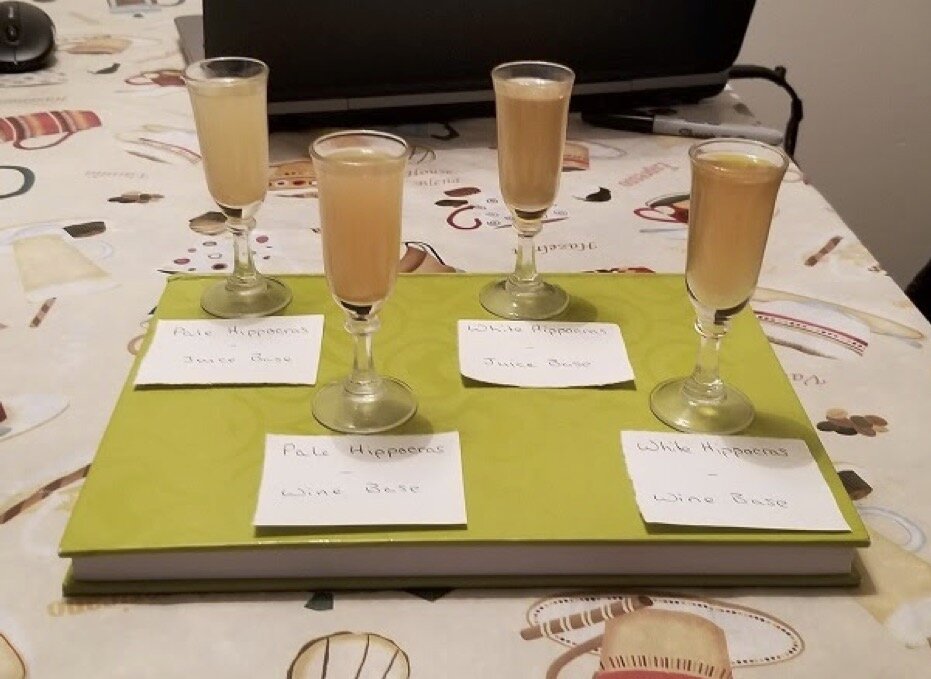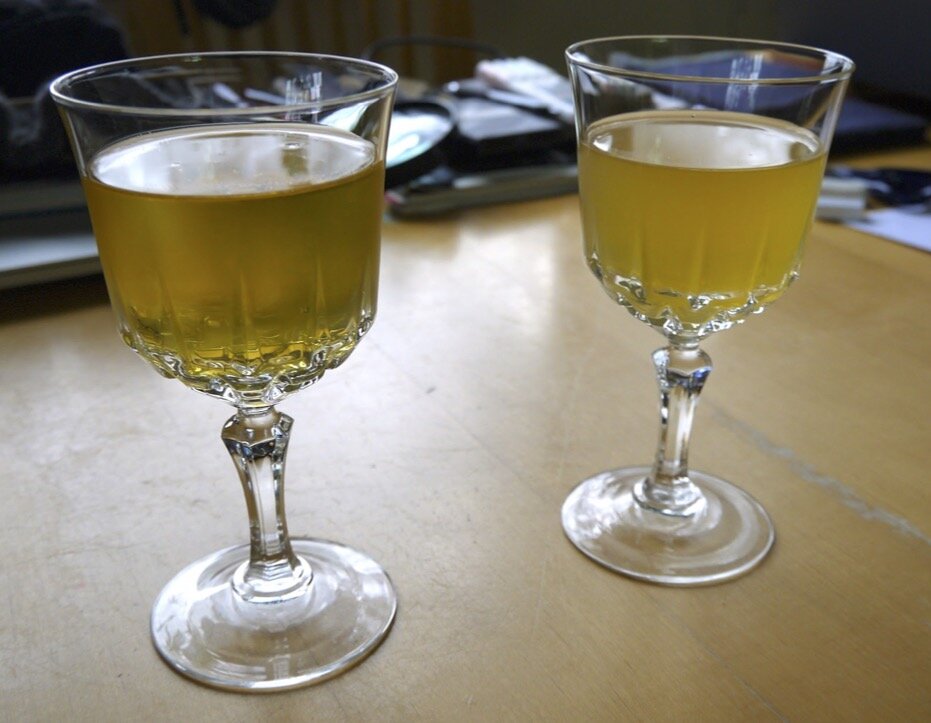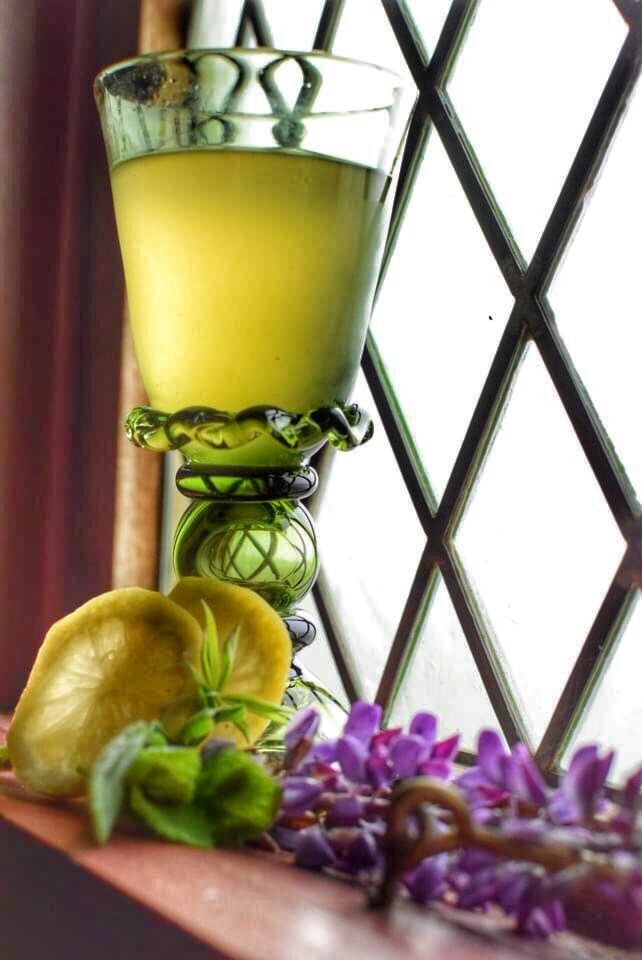Week 1 - Hippocras .... or ypocras….or whatever
Lori’s pale hippocras on the windowsill at the Colony’s 17th century kitchen. Photo courtesy Lori Pittman.
Cue the trumpets! Welcome to Week 1 of the Colony of Avalon’s 2021 Great Colonial Cook Off
Keeping with tradition, we’re kicking things off with a beverage. And while a steaming hot mug of something with a warming kick would be perfect in Ferryland this week (where it’s a mere 9 degrees Celsius today), those of you suffering through the heat wave will be happy to hear that we’ve gone for something more refreshing.
NOTE: For first time cook-offers, you’ll find a modern interpretation of this recipe plus directions on how to enter this week’s prize draw at the bottom of this post. Just scroll down.
Hippocras
Also known as ypocras, vpocrate, ipocras, ipocrist, hipocras, ippocras, hvpocras, hvppocras, hypocrace, hvpocraze, ippocrass…. Whatever the heck you choose to call it, this week’s recipe is pretty simple: take a mixture of spices, bruise them in a mortar, and steep in sweetened wine (or juice for you junior cook-offers) for 2-24 hours. Strain, chill and serve. That’s it!
There are literally hundreds of recipes for this drink, dating from the 13th century right up to the present day Not surprisingly, ingredients for the gyle, or spice mixture, reflect the food trends of the day. Earlier cooks were fond of spices like cubeb berries, grains of paradise and long peppers. Later recipes include citrus fruit and almonds. Since not everyone has access to grains of paradise, we’ve chosen two of Francois Massialot’s recipes for Hippocras from The Court and Country Cook, published in 1702. The first, for White Hippocras, uses a pretty accessible mix of cinnamon, mace, black pepper and lemon. The second, for Pale Hippocras, includes almonds and coriander.
A few points before you get started. First, if you ask the Googler about hippocras, you’ll find plenty of sources stating that the gyle mixture was added to improve the taste of old or spoiled wine. Like most things on the internet, this should be taken with a large grain of salt. A good number of the original recipes we’ve consulted, including this one from The Lady Grace Castleton's Booke of Receipts, clearly direct cooks to use “good wine”.
To Make Hippocras from The Lady Grace Castleton's booke of receipts [manuscript] from the collection of the Folger Shakespeare Library. Note the directions in the fifth line of the recipe to “steep in a gallon of good wine”. View the complete manuscript here.
Second, while many recipes list ground spices in their ingredient list, it’s waaaaaaay easier to remove the gyle if you use whole spices, for example a cinnamon stick instead of ground cinnamon. If you don’t have access to whole spices, don’t sweat it. You can strain your hippocras through a coffee filter, a pudding bag, or something with an equally fine mesh. In fact, hippocras gets its name from the manicum hippocraticum, or sleeve of Hippocrates; a fine linen bag used by apothecaries to filter their various concoctions.
Interestingly, later recipes use whole milk or cream as a means of removing ground spices from the wine. According to historic food guru Ivan Day, the milk curdles on contact with the acidic wine, and slowly sink to the bottom, carrying the gritty spice particles with them. If red wine is used, this filtering process removes a certain amount of the pigment, so a plant dye known as turnsole was often added to restore the wine’s original red colour. We have plans to try the milk filtering method later this week. Stay tuned to the Colony’s Facebook page for the results. Or, try it yourself and let us know how it goes.
Feel free to make this recipe your own. Improvise and experiment with the gyle. Herbs or edible flowers? Red wine instead of white? A short steep or an extra long one? Why not. We can’t wait to see what fantastic combinations you come up with. Need some inspiration? Day’s website includes a “Guide to Hippocras Spices” that lists the spices most commonly cited in period Hippocras recipes.
Finally, A HUGE shout out to Cook Off Insider Elizabeth Slucas (WOOT! WOOT!) who took Maissolot’s recipe for a test drive. She’s generously provided a modern interpretation of his recipe, along with a few handy tips and tricks. Elizabeth says she’ll be doing further experimentation as the week goes on. Watch the Colony of Avalon’s Facebook page for her results.
Your Chance to Win
Remember, snap a pic of your hyppocas and post it as a comment under the Week 1 recipe on our Facebook page for a chance to win this week’s prize - a fabulous CKBK apron. Never heard of CKBK? It’s an on-line library of hundreds of cookbooks, ranging from historical references to contemporary classics to recent releases. It’s like crack for cooks! And thanks to the generous folks at CKBK, anyone who enters week one of this season’s Colonial Cook Off can take it for a FREE test drive! Get your entry in by 11:59 PM, Friday, July 9, 2021 and you’ll automatically receive a free 30-day CKBK premium subscription. Thanks CKBK!
Recipe 1 - White Hippocras
Ingredients
2 c white wine (can sub apple or white grape juice)
1/4 lemon, roughly chopped
1/4 c sugar or honey (omit if using juice)
1/4 cinnamon stick
1 tsp whole mace
2-3 grains black peppercorn, lightly crushed
Directions
Place all the ingredients in a non-reactive container
Stir to combine
Infuse for 2 hours, shaking or stirring occasionally.
Strain well.
Served chilled or warm
Recipe 2 - Pale Hippocras
Ingredients
2 c white wine (sub apple or grape juice)
1/4 c sugar or honey (omit if using juice)
1/4-1/2 lemon, roughly chopped
1-2 whole cloves
1/4 cinnamon stick
2-3 grains white peppercorn, lightly crushed
2-3 grains coriander seed, lightly crushed
4-6 blanched almonds, roughly chopped
Directions
Place all the ingredients in a non-reactive container
Stir to combine
Infuse for 1-2 hours, shaking or stirring occasionally
Strain well
Served chilled or warm
Notes from Elizabeth
I decreased the sugar in both recipes since I used a sweeter wine, but you can add more or less to taste if desired.
In my initial hippocras experiment, I made both the white and the pale recipes in two batches: white wine ($4 bottle of chardonnay, you don’t have to splurge on anything super expensive here) and white grape juice.
If you’re like me and you don’t have access to spices in bulk or at reasonable prices, buy one bottle of mixed peppercorns and sort them by color (seriously!).
You can use ground spices, but it will be more difficult to strain (trust me, this is from experience). I used ground cinnamon, so even after straining my results are a little cloudy.
I measured and placed all of my ingredients in mason jars, sealed them, set a timer, and gave them a shake about every 15 minutes. I let all my mixtures infuse for 2 hours total, then strained it once.
If you decide to do a few different batches, I would highly recommend labelling them as they do look and smell very similar at the beginning.
I served mine at room temperature for our first taste test. The pale hippocras has a slightly more smooth and subtle flavor, with a more pronounced citrus hint. The white reminded me mostly of apple pie. The grape juice versions were much sweeter than the wines, but still pleasant to drink.
For my second experiment, I followed the above modern recipes with the following changes:
Wine version: used Pinot Grigio
Could not find mace at the stores so used nutmeg as a substitute 1:1
For the filtering, I ran the white hippocras through a paper coffee filter twice. The pale hippocras went through the paper coffee filter once.
Drinks were chilled before tasting.
Juice version: used apple juice and substituted the nutmeg for mace. Otherwise, followed the recipe.
Elizabeth’s Verdict
These recipes are definitely winners!! My taste tester preferred the white hippocras. We both really liked both drinks. If pressed to decide between the two recipes, I would have to vote for the pale hippocras. Such a great drink, without the acidic problems that generally come with drinking straight white wine!








![To Make Hippocras from The Lady Grace Castleton's booke of receipts [manuscript] from the collection of the Folger Shakespeare Library. Note the directions in the fifth line of the recipe to “steep in a gallon of good wine”. View the complete manuscript here.](https://images.squarespace-cdn.com/content/v1/559e8c67e4b07b91861183d4/1625313402720-BRU823Q1V0E4FVY49WUZ/castleton-v-a-600-85.jpg)
